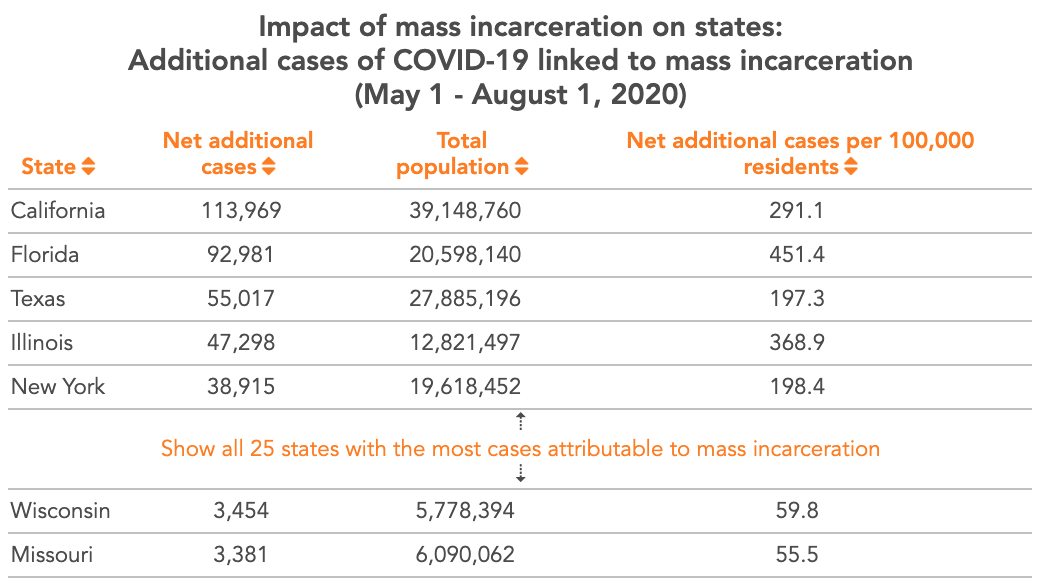New report shows that mass incarceration led to huge increase in national COVID-19 caseloads
The study provides the first estimates of how prisons and jails led to more coronavirus infections, both inside and outside prisons.
December 15, 2020
Over half a million COVID-19 cases this summer were directly linked to mass incarceration, a new report from the Prison Policy Initiative and Professor Gregory Hooks shows. The study provides the first estimates of how prisons and jails — which are “super spreaders” of the virus — added to COVID-19 caseloads on the county, state, and national levels, including infections of people both inside and outside prisons.
“Our findings leave no doubt that locking up millions of people in this country in close quarters has led to mass sickness and death in 2020, both in and outside of prisons,” said Hooks. “This huge growth in COVID-19 cases isn’t the fault of incarcerated people; it’s the fault of tough-on-crime politicians who insist that mass incarceration is necessary to keep us safe.”
In the study, titled Mass Incarceration, COVID-19, and Community Spread, Hooks compared the population density of incarcerated people in U.S. counties to the growth in COVID-19 cases in those counties over the summer of 2020. To get a more direct measure of community spread across county lines, he also measured the impact on county caseloads from prison and jail populations held in nearby counties located within the same multi-county economic areas. The findings include:
- At the county level: Over the summer of 2020, large prisons and jail populations within nonmetro counties (i.e. rural areas or those with small cities) directly contributed to higher COVID-19 caseloads in those counties.
- At the regional level: COVID-19 caseloads grew much more quickly over the summer among counties in greater economic areas containing large prisons and jails.
- At the national level: Mass incarceration led to more than half a million additional COVID-19 cases nationwide – or about 1 in 8 of all new cases – over the summer, including cases both inside and outside correctional facilities.
The report, written to be accessible to a general audience, includes graphics illustrating the major findings, as well as several tables listing the number of COVID-19 cases attributable to mass incarceration in the most heavily impacted states and economic areas. Additional appendix tables provide estimates of additional cases linked to incarceration for every county, economic area, and state in the U.S.
As the report explains, prisons and jails offer ideal conditions for the transmission of the coronavirus and have had the largest COVID-19 outbreaks in the U.S. on most days in 2020. A team of epidemiologists predicted in April that mass incarceration would lead to hundreds of thousands of additional cases in the U.S. In June, the Prison Policy Initiative released a report with the ACLU showing that states were failing at the one effort likely to prevent such a tragedy: the safe reduction of prison and jail populations. As of mid-November, the Prison Policy Initiative has shown, prison and jail populations are still dangerously high.
“Now that we have the first national numbers showing how prisons and jails sped up the spread of COVID-19, lawmakers need to take action to depopulate these facilities, or we will see even more preventable cases and deaths linked to the conditions in prisons and jails,” said Prison Policy Initiative Research Director Wendy Sawyer, co-author of Mass Incarceration, COVID-19, and Community Spread. “Even though the COVID-19 vaccine is rolling out, it will be months before the virus stops cycling through correctional facilities, and the action states have taken so far has not been enough to slow it down. So far, we’ve seen that too many lawmakers don’t care enough about people in prison to take action on their behalf, but our findings show that failing to reduce prison populations during the pandemic has led to more people outside prison getting sick as well.”
The full report is available at https://www.prisonpolicy.org/reports/covidspread.html.




